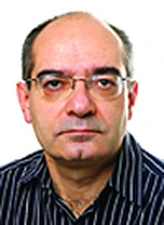Stéphan Fauve

The 2009 Lewis Fry Richardson Medal is awarded to Stéphan Fauve for his many contributions to nonlinear geosciences, mainly through elegant laboratory experiments with wide applications to turbulence (thermal convection, surface waves and wave turbulence, pattern dynamics) and his significant contribution to the recent spectacular results on processes related to the geodynamo. The latter results are a major experimental achievement in magnetohydrodynamics with important applications to geophysics.
The field of nonlinear dynamics and spontaneous pattern formation in fluids has flourished across the world in the past decades, along with its applications to geophysical phenomena. One of the leaders in this development has been Stéphan Fauve from the École Normale Supérieure in Paris. Dr. Fauve has been involved early in his career in experiments on and the theory of thermal convection; this basic process occurs in most planetary and astrophysical systems and its study provides a paradigmatic example for research in nonlinear fluid dynamics.
Stéphan Fauve designed novel, exquisitely precise experiments to study codimension-two bifurcations and subcritical bifurcations in rotating and non-rotating layers of convection in liquid metals. During this period he also performed, with François Heslot, the first experiment on stochastic resonance. This phenomenon has become of increasing importance for the understanding of processes in the geophysical sciences where small periodic forcing interacts with random perturbations.
Among condensed-matter physicists, Stéphan Fauve is best known for his experiments on the Faraday instability. His discovery of the quasi-crystalline pattern was unexpected and gave rise to numerous theoretical analyses. Later he performed similar experiments with granular media that played a pioneering role in the now flourishing field of granular system dynamics.
During the last decade, Professor Fauve has attacked problems of magneto-hydrodynamics and in particular the challenge of the experimental homogeneous dynamo. The recent success of the von Karman sodium (VKS) dynamo experiment – carried out with François Daviaud, Jean-François Pinton and many other collaborators – owes much to Fauve’s ideas, as well as to the whole team’s persistence in overcoming major experimental difficulties. While previous dynamo experiments were performed with guided flows of sodium, the idea of Fauve and colleagues was to create a turbulent dynamo with an unconstrained velocity field, as is the case for planetary and stellar dynamos. This allows one, for example, to observe magnetic field reversals. Stéphan Fauve is not only an ingenious experimenter, but he is also a deep theoretician. Often his ideas have opened new perspectives in well-studied fields of research. His own experiments, as well as those of others, have benefited from the simple and luminous nonlinear theories that he has formulated for their description.
Professor Fauve has thus proven himself, repeatedly and consistently, an international leader in the field of experimental and theoretical nonlinear processes and their application to the geosciences and other fields.